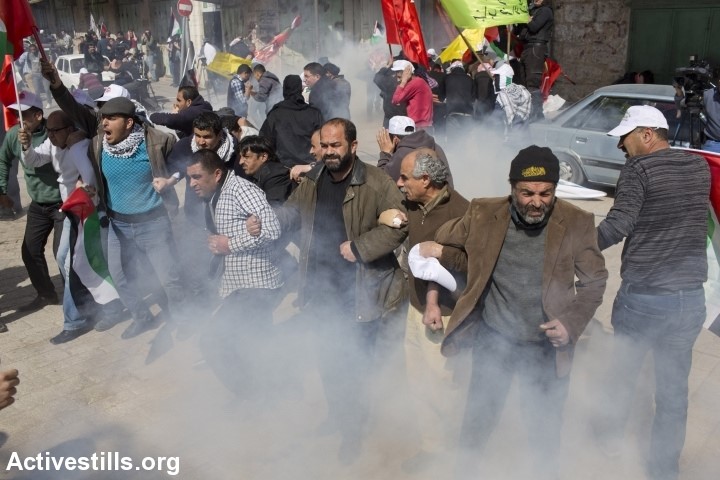2,000 marched in Hebron on Friday, among them Israeli peace activists and Hadash members, to mark the 20th anniversary of the massacre of 29 Palestinians in a mosque by a settler, and 13 were injured when Israeli forces dispersed the demonstration. The clashes erupted following a large demonstration organized by the activist group “Youths against Settlements” calling for the re-opening of Shuhada Street, a major Hebron thoroughfare closed to Palestinians by Israeli forces since 1994.

2,000 marched in Hebron to mark the 20th anniversary of the massacre of 29 Palestinians in a mosque by a Jewish extremist, and 13 were injured when Israeli forces dispersed the demonstration (Photo: Activestills)
Hebron governor Kamil Hmeid and lawmaker Mustafa al-Barghouthi were among the participants in the march. Coordinator for Youths against Settlements, Issa Amro, said that Israeli forces chased protesters into the Bab al-Zawya neighborhood and fired rubber-coated steel bullets, injuring at least 13. Among the injured were Badee al-Dweik, Tamer al-Atrash, Issa Amro, Mohammad Zughayyer, and Farid al-Atrash. DFLP political bureau member Majida al-Masri suffered from excessive tear gas inhalation.
The protests come on the fifth anniversary of the launch of the campaign “Open Shuhada Street,” a local campaign to force Israeli authorities to re-open one of central Hebron’s main thoroughfares to Palestinian traffic. The street was shuttered in 1994 after a Jewish extremist entered the nearby Ibrahimi Mosque and opened fire, killing 29 worshipers and injuring 125. According to Israeli human rights group B’Tselem, by 2007 over 40 percent of the area’s Palestinian homes had been abandoned and three-quarters of commercial establishments had shut down due to the severe difficulties they faced as a result of the street closure and checkpoints.
500 Israeli settlers live in Hebron’s Old City, many of whom have illegally occupied Palestinian houses and forcibly removed the original inhabitants. They are protected by thousands of Israeli forces, and frequently harass local Palestinians.
According to Ma’an news agency, dozens of Palestinians were injured on Friday in clashes with Israeli forces across the northern and central West Bank. Clashes occurred in a number of areas across the region, including al-Jalazun, Bilin, Nabi Saleh, and Khirbet Atuf, a small village near Tubas, on a day that saw dozens wounded in the southern West Bank city of Hebron and the Gaza Strip as well.
Al-Jalazun
Clashes erupted at the entrance to al-Jalazun refugee camp north of Ramallah when Israeli forces dispersed dozens of protesters after Friday noon prayers by shooting tear gas canisters as well as metal and rubber-coated steel bullets. Four people were injured with metal and rubber-coated steel bullets, while dozens suffered from excessive tear gas inhalation.
Bilin
Two people were injured and dozens suffered from excessive tear gas inhalation in the village of Bilin west of Ramallah when Israeli forces dispersed the village’s weekly protest against the separation wall. Israeli forces fired tear gas, stun grenades, and rubber-coated steel bullets as protesters neared lands that have been confiscated from them located near the wall. Medic Mohammad Ahmad Yassin, 24, was injured after being hit with a tear gas canister in the back, and Mahmoud Mohammad, 18, was hit with a rubber-coated steel bullet in the head.
Since 2005, Bilin villagers have protested on a weekly basis against the Israeli separation wall that runs through their village on land confiscated from local farmers. Previous protests by Bilin activists have forced the Israeli authorities to re-route the wall, but large chunks of the village lands remain inaccessible to residents because of the route.
Nabi Saleh
Israeli forces violently dispersed a protest against Israeli settlements and the occupation in Nabi Saleh with rubber and metal-bullets as well as tear gas canisters. The weekly demonstration included dozens of women and children, in addition to foreign activists, and dozens suffered from excessive tear gas inhalation. Israeli soldiers deployed heavily inside the village itself after attacking the demonstration, declaring it a “closed military zone.” Local youths responded by throwing rocks at the troops as they moved through the village.
Activists in Nabi Saleh have been protesting weekly against the occupation for four years, demanding that their lands confiscated by Israeli forces to build the separation wall be returned. In 2004, the International Court of Justice called on Israel to stop construction of the separation wall within the occupied West Bank. When completed, 85 percent of the wall will run inside the West Bank.
Atuf
Clashes also broke out in the village of Khirbet Atuf east of Tubas after dozens of Palestinians performed Friday prayers near the Al-Fasel Trench, near the Jordan Valley, to protest Israeli settlement activity in the area. Dozens suffered from excessive tear gas inhalation in clashes.
Gaza Strip
13 Palestinians were injured on Friday when Israeli forces opened fire on protesters near the border east of Jabaliya in the Gaza Strip. The internationally recognized Palestinian territories of which the West Bank, East Jerusalem, and the Gaza Strip form a part have been occupied by the Israeli military since 1967.


